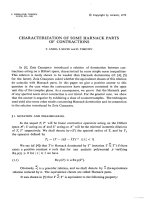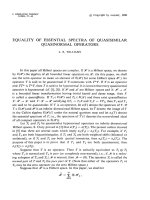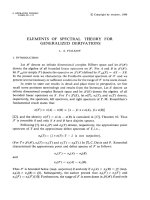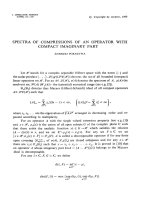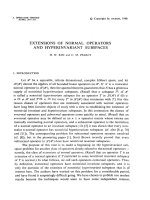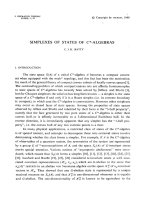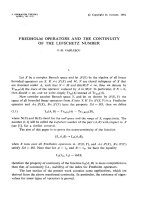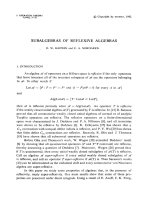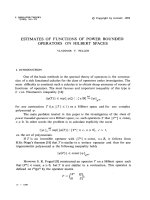Báo cáo toán học: "Asymptotics of Some Convolutional Recurrences" pps
Bạn đang xem bản rút gọn của tài liệu. Xem và tải ngay bản đầy đủ của tài liệu tại đây (129.86 KB, 11 trang )
Asymptotics of Some Convolutional Recurrences
Edward A. Bender
∗
Department of Mathematics
University of California, San Diego
La Jolla, CA 92093-0112
Adri B. Olde Daalhuis
Maxwell Institute and School of Mathematics
The University of Edinburgh
Edinburgh, EH9 3JZ, UK
Zhicheng Gao
†
School of Mathematics and Statistics
Carleton University
Ottawa, Ontario K1S5B6
L. Bruce Richmond
∗
and Nicholas Wormald
‡
Department of Combinatorics and Optimization
University of Waterloo
Waterloo, Ontario N2L3G1
,
Submitted: Apr 7, 2009; Accepted: Dec 14, 2009; Published: Jan 5, 2010
Abstract
We study the asymptotic behavior of the terms in sequences satisfying recur-
rences of the form a
n
= a
n−1
+
n−d
k=d
f (n, k)a
k
a
n−k
where, very roughly speaking,
f (n, k) behaves like a product of reciprocals of binomial coefficients. Some examples
of such sequences from map enumerations, Airy constants, and Painlev´e I equations
are discussed in detail.
1 Main results
There are many examples in the literature of sequences defined recursively using a con-
volution. It often seems difficult to determine the asymptotic behavior of such sequences.
In this not e we study the asymptotics of a general class of such sequences. We prove
∗
Research supported by NSERC
†
Research supported by NSERC
‡
Research supported by NSERC and Cana da Research Chair Program
the electronic journal of combinatorics 17 (2010), #R1 1
sub exponential g r owth by using a n iterative method that may be useful for other recur-
rences. By subexponential growth we mean that, for every constant D > 1, a
n
= o(D
n
)
as n → ∞. Thus our motivation for t his note is both the method and the applications
we give.
Let d > 0 be a fixed integer and let f (n, k) 0 be a function that behaves like a
product of some powers of reciprocals of binomial coefficients, in a general sense to be
specified in Theorem 1. We deal with the sequence a
n
for n d where a
d
, a
d+1
, ···, a
2d−1
0 are arbitrary and, when n 2d,
a
n
= a
n−1
+
n−d
k=d
f(n, k)a
k
a
n−k
. (1)
Without loss of generality,
we assume that f (n, k) = f(n, n −k)
since we can replace f(n, k) a nd f(n, n −k) in (1 ) with
1
2
(f(n, k) + f(n, n −k)).
Theorem 1 proves subexponential growth. Theorem 2 provide more accurate estimates
under a dditional assumptions. In Section 2, we apply the corollary to some examples.
Theorem 1 (Subexponential growth) Let a
n
be defined by recursion (1 ) w i th a
d
> 0.
Suppose there is a function R(x) defined on (0, 1/2], an α > 0 and an r such that
(a) 0 < R(x) < r < 1,
(b) lim
x→0+
R(x) = 0,
(c) 0 f(n, k) = O
n
−α
R
k−d
(k/n)
uniformly for d k n/2.
Then a
n
grows subexponentially; in fact,
a
n
= ( 1 + O(n
−α
)) a
n−1
. (2)
Proof: We first note that the a
n
are non-decreasing when n 2d − 1.
Our proof is in three steps. We first prove that a
n
= O(C
n
) f or some constant
C > 2. We then prove that C can be chosen very close to 1. Finally we deduce (2) and
sub exponential growth.
First Step: Since the bound in (c) is bounded by some constant times the geometric
series n
−α
r
k−d
with ratio less than 1,
n−d
k=d
f(n, k) = O(n
−α
). Hence we can choose M
so large that
n−d
k=d
f(n, k) < 1/4 when n > M. Next choose C 2 so large (C =
max{a
d
, a
d+1
, , a
2d−1
, a
M
, 2} will do) that a
n
< 2C
n
for n M. By induction, using the
recursion (1), we have for n > M
a
n
< 2C
n−1
+ (1/4)4C
n
C
n
+ C
n
= 2C
n
.
the electronic journal of combinatorics 17 (2010), #R1 2
Second Step: By (b) t here is a λ in (0, 1/2) such that R(x) <
1
2C
for 0 < x < λ. Fix
any D C such that a
n
= O(D
n
), which is true for D = C by the First Step.
Split the sum in (1 ) into λn k (1 −λ)n and the rest, calling the first range of k
the “center” and the rest the “tail”. Noting r < 1, the center sum is bounded by
2
n/2
k=λn+1
f(n, k)a
k
a
n−k
= O
D
n
n/2
k=λn+1
r
k−d
= O
(r
λ
D)
n
. (3)
Since a
j
are increasing, the tail sum is bounded by
2
λn
k=d
f(n, k)a
k
a
n−k
= O(n
−α
)a
n−1
λn
k=d
R(x)
k−d
D
k
(4)
= O(n
−α
)a
n−1
λn
k=d
(DR(x))
k−d
= O
n
−α
a
n−1
,
where the last equality follows from the fact that DR(x) < 1 /2. Combining (3) and (4),
a
n
=
1 + O(n
−α
)
a
n−1
+ O((r
λ
D)
n
). (5)
When r
λ
D > 1, induction on n easily leads to a
n
= O((r
λ
D
′
)
n
) for any D
′
> D, an
exponential growth rate no larger than r
λ
D
′
.
Since r
λ
has a fixed value less than one, we can iterate this process, replacing D by
r
λ
D
′
at the start of the Second Step. We finally obtain a growth rate D > 1 with r
λ
D < 1.
This completes the second step.
Third Step: With the value of D just obtained, the last term in (5) is exponentially
small and hence is O(n
−α
a
n−1
). Thus we obtain (2) which immediately implies subexpo-
nential growth of a
n
, since 1 + O(n
−α
) < D for any D > 1 and sufficiently large n.
To say more than (2), we need additional information about the behavior of the f(n, k).
When f(n, k)/f(n, d) is small for each k in the range d + 1 k n −d −1, the first and
last terms dominate the sum. The following theorem is based on this observation.
Theorem 2 (Asymptotic behavior) Assume (a)–(c) of Theorem 1 hold. Suppose fur-
ther that there is a β > 0 such that
f(n, k)
f(n, d)
= O(n
−β
r
k−d−1
) uniformly fo r d + 1 k n/2. (6)
Then
log a
n
= 2a
d
n
k=2d+1
f(k, d) + O
n
k=2d
f(k, d)
k
−α
+ k
−β
. (7)
the electronic journal of combinatorics 17 (2010), #R1 3
Proof: We assume n > 2d. Remove the k = d and k = n − d terms from the sum in (1).
We first deal with the remaining sum. Theorem 1 gives a
k
= O(D
k
) for all D > 1, so we
can assume D < 1/r. Using (6)
n−d−1
k=d+1
f(n, k)a
k
a
n−k
= O
f(n, d)n
−β
a
n−1
n/2
k=d+1
r
k−d−1
D
k
= O
f(n, d)n
−β
a
n−1
.
Combining this with (1), we obtain
a
n
= a
n−1
+ 2a
d
f(n, d)a
n−d
+ f(n, d)O(n
−β
)a
n−1
= a
n−1
1 + 2a
d
f(n, d) + {O(n
−α
) + O(n
−β
)}f(n, d)
,
Ta king logarithms and noting for expansion purposes that f(n, d) = O(n
−α
), we obtain
log a
n
− log a
n−1
= 2a
d
f(n, d) + O
n
−α
+ n
−β
f(n, d)
.
Sum over n starting with n = 2d + 1. The theorem follows immediately when we note
that the constant t erms can be incorporated into the O( ) in (7) since the sum therein is
bounded below by a nonzero constant.
Corollary 1 Assume the conditions of Theorem 2 hold and f(n, d) = Θ(n
−α
).
• If α < 1, then a
n
= exp ( Θ (n
1−α
)).
• If α > 1, then a
n
= K + O(n
1−α
) for some constant K.
• If f(n, d) − A/n are the terms of a convergent series, then a
n
∼ Cn
2Aa
d
for some
positive co nstant C.
Proof: Since α > 0 and β > 0, (7) gives log a
n
= Θ(
n
k=2d+1
k
−α
). The case α < 1 follows
immediately; for α > 1, we see that a
n
is bounded and nondecreasing and therefore has
a limit K. For m > n, (2) gives log(a
m
/a
n
) = O( n
1−α
) uniformly in m. Letting m → ∞,
we obtain the claim regarding α > 1.
For α = 1, the first sum in (7 ) is A log n + B + o(1) for some constant B, and the last
sum in (7) converges.
2 Examples
We apply Theorem 2 and Corollary 1 to some recursions which arise from combinatorial
applications. In our examples, f(n, k) behaves like a product of the r eciprocal of binomial
coefficients, which satisfies the conditions of Theorems 1 and 2. A more general case of
interest is when f(n, k) takes the fo rm of the product of functions like
g(n, k) =
[a]
k
[a]
n−k
[a]
n
the electronic journal of combinatorics 17 (2010), #R1 4
for some constant a > 0, where [x]
k
= x(x+ 1) ···(x+ k −1) =
Γ(x+k)
Γ(k)
, the r ising factorial.
We note that when a = 1, g(n, k) =
n
k
−1
.
We begin with some useful bounds. When a > 0 and 1 k n/2,
g(n, k) =
k−1
j=0
a + j
a + n − k + j
<
a + k
a + n
k
(8)
(k/n)
k
1 + a/k
1 + a/n
k
= O
(k/n)
k
= O
n
−1
(3k/2n)
k−1
since k(2/3)
k−1
is bounded. So g satisfies the condition on f in Theorem 1(c), with α = 1.
Similarly, when a > 0 and d k n/2,
g(n, k)
g(n, d)
=
k−d−1
j=0
a + d + j
a + n − k + d + j
= O
n
−1
(3k/2n)
k−d−1
. (9)
This is in accordance with (6) with β = 1.
Example 1 (Map enumeration constants) There are numbers t
n
appearing in the
asymptotic enumeration of maps in an orientable surface of genus n, whose value does
not concern us here. Define u
n
by
t
n
= 8
[1/5]
n
[4/5]
n−1
Γ
5n−1
2
25
96
n
u
n
.
Then u
1
= 1/10 and u
n
satisfies the following recursion [3]
u
n
= u
n−1
+
n−1
k=1
f(n, k)u
k
u
n−k
for n 2, (10)
where
f(n, k) =
[1/5]
k
[1/5]
n−k
[1/5]
n
[4/5]
k−1
[4/5]
n−k−1
[4/5]
n−1
.
From the observations above, the conditions of Theorem 2 are satisfied with d = 1,
R(λ) = (3λ/2)
2
and α = β = 2. Hence, u
n
∼ K for some constant K. Unlike the proof
in [3], this does not depend on the value of u
1
.
Example 2 (Airy constants) The Airy co nstants Ω
n
are determined by Ω
1
= 1/2 and
the recurrence [7]
Ω
n
= (3n −4)nΩ
n−1
+
n−1
k=1
n
k
Ω
k
Ω
n−k
for n 2.
the electronic journal of combinatorics 17 (2010), #R1 5
Let Ω
n
= n! [2/3]
n−1
3
n
a
n
. Then a
n
satisfies (1) with d = 1 and
f(n, k) =
[2/3]
k−1
[2/3]
n−k−1
[2/3]
n−1
.
Theorem 2 applies with d = 1, R(λ) = 3λ/2 and α = β = 1. Since
f(n, 1) =
1
n −4/3
=
1
n
+
4/3
n(n −4/3)
and a
1
= 1/6, we have a
n
∼ Cn
1/3
for some constant C.
We note that it is possible to apply the result of Olde Daalhuis [13] to obtain a full
asymptotic expansion for Ω
n
. Let
A
n
=
Ω
n
3
n
n!
.
Then the recursion for Ω
n
becomes
A
n
= (n −4/3) A
n−1
+
n−1
k=1
A
k
A
n−k
, n 2.
It follows that the formal series
F (z) =
n1
A
n
z
n
satisfies the Riccati equation
F
′
(z) +
1 +
1
3z
F (z) −F
2
(z) −
1
6z
= 0.
It then follows from the result of Olde Daalhuis [13] that
A
n
∼
1
2π
∞
k=0
b
k
Γ(n −k), as n → ∞,
where b
0
= 1 and b
k
can be computed using the recursion
b
k
=
−2
k
k+1
j=2
b
k+1−j
A
j
, k 1.
In particular, we have
Ω
n
∼
1
2π
Γ(n)3
n
n! =
1
2πn
(n!)
2
3
n
, as n → ∞.
It is well known that solutions to the Riccati equation have infinitely many singulari-
ties, hence F (z) (via its Borel transform [2]) cannot satisfy a linear ODE with polynomial
coefficients. This implies that the sequence A
n
(and hence Ω
n
) is not holonomic.
the electronic journal of combinatorics 17 (2010), #R1 6
Example 3 The following recursion, with ℓ > 0 and ℓ = 1/2, appeared in [6]. The
Airy constants are the special case ℓ = 1. The case ℓ = 2 corresponds to the recursion
studied in [9, 10], which arises in the study of the Wiener index of Catalan trees. We have
C
1
=
Γ(ℓ−1/2)
√
π
and, for n 2,
C
n
= n
Γ(nℓ + (n/2) −1)
Γ((n −1)ℓ + (n/2) − 1)
C
n−1
+
1
4
n−1
k=1
n
k
C
k
C
n−k
. (11)
Define a
n
by C
n
= n! g(n)a
n
where g(1) = 1 and
g(m) =
m
k=2
Γ(kℓ + (k/2) − 1)
Γ((k − 1)ℓ + (k/2) −1)
.
Then (11) becomes
a
n
= a
n−1
+
n−1
k=1
g(k)g(n −k)
4g(n)
a
k
a
n−k
,
so f(n, k) = g(k)g(n − k)/4g(n).
With a fixed and x → ∞ and using 6.1.47 on p.257 of [1] (or using Stirling’s formula),
we have
Γ(x + a)
Γ(x)
= x
a
1 +
a(a −1)
2x
+ O(1/x
2
)
= x
a
1 +
a −1
2x
a
1 + O(1/x
2
)
(12)
=
x +
a −1
2
a
1 + O(1/x
2
)
. (13)
When m > 1, (13) gives us
g(m) =
m
k=2
(2ℓ + 1)k − ℓ −3
2
ℓ
1 + O(1/k
2
)
= Θ(1)
(ℓ + 1/2)
m
m
k=2
k −
ℓ + 3
2ℓ + 1
ℓ
= Θ(1)
(ℓ + 1/2)
m
[a]
m−1
ℓ
, where a =
3ℓ −1
2ℓ + 1
.
Hence
f(n, k) = Θ(1)
[a]
k−1
[a]
n−k−1
[a]
n−1
ℓ
.
where the absolute values have been introduced to allow for a < 0. A slight adjustment
of the argument leading to (8) and (9) leads to
f(n, k) = O(n
−ℓ
(3k/2n)
ℓ(k− 1)
) and
f(n, k)
f(n, 1)
= O(n
−ℓ
(3k/2n)
ℓ(k− d−1)
)
the electronic journal of combinatorics 17 (2010), #R1 7
for 1 k n/2. Hence Theorem 2 applies with α = β = ℓ, and a
n
converges to a
constant when ℓ > 1 by Corollary 1.
It is interesting to note that there is a simple relation between the sequence u
n
in
Example 1 and the sequence a
n
in Example 3 with ℓ = 2. It is not difficult to check that
the f(n, k) defined in Example 3 is exactly five times the f (n, k) in Example 1: since
a
1
= 5u
1
, we have a
n
= 5u
n
for all n 1. This simple relation suggests a relationship
between the number o f maps on an orientable surface of genus g and the gth moment of
a particular toll function on a certain type of t rees. Using a bijective approach, Chapuy
[4] recently found an expression for t
g
as the gth moment of the labels in a random
well-labelled tree.
3 A convolutional r ecursion arising from Painlev´e I
The following is recursion (44) in [11].
α
n
= (n −1)
2
α
n−1
+
n−2
k=2
α
k
α
n−k
, n 1, n 3. (14)
It follows from Proposition 14 of [11] that, for 0 < α
1
< 1 and α
2
= α
1
− α
2
1
,
α
n
= c(α
1
)((n −1)!)
2
1 −
2α
2
(n −3)
3(n −1)
2
(n −2)
2
+ δ
n
, (15)
where c(α
1
) depends only on α
1
, and
δ
n
= O(1/n
4
).
We note that α
n
for n 3 depends only on α
2
. The proof of (15) relies on the fact
that 0 < α
2
< 1/4 for 0 < α
1
< 1. It is conjectured in [11] that the asymptotic expression
(15) actually holds for a wider range of values of α
1
.
For n 1, let
p
n
=
α
n
((n −1)!)
2
.
Then, as shown in [11], p
n
satisfies recursion (1) with d = 2 and
f(n, k) =
(n −k −1)!(k − 1)!
(n −1)!
2
.
We note here f(n, 2 ) = O(n
−4
). It follows from Theorem 2 that
p
n
= p(1 + ǫ
n
) f or a ny α
2
> 0,
where p = p(α
2
) is a positive constant and ǫ
n
= O(1/n
3
).
the electronic journal of combinatorics 17 (2010), #R1 8
It is also interesting to note that, with α
1
= 1/ 50, α
2
= 4 9 / 2500, the sequence α
n
is
related to the sequence u
n
in Example 1 by
α
n
= [1/5]
n
[4/5]
n−1
u
n
.
As mentioned in [11], the formal series v(t) =
n1
α
n
t
−n
satisfies
t
2
v
′′
+ tv
′
− (t + 2α
1
)v + tv
2
+ α
1
= 0, (16)
and hence, with
t =
8
√
6
25
x
5/2
,
y(x) = (x/6)
1/2
(1 −2v(t)) satisfies the following Painlev´e I:
y
′′
= 6y
2
− x.
This connection with Painlev´e I is used in [8] to show that the sequence α
n
is not holonomic
(It follows that u
n
and t
n
in Example 1 are also not holonomic). The proof uses the fact
that solutions to Painlev´e I have infinitely many singularities and hence cannot satisfy a
linear ODE with polynomial coefficients.
In the following we apply the techniques of [14] to prove that (15) holds for any complex
constant α
1
. It is convenient to introduce the formal series
u
0
(z) = v(z
2
) =
∞
n=2
b
n
z
−n
=
∞
n=1
α
n
z
−2n
.
It follows from (16) that u = u
0
(z) is a formal solution to the differential equation
1
4
u
′′
+
1
4z
u
′
−
1 +
2α
1
z
2
u + u
2
+
α
1
z
2
= 0.
The Stokes lines for this differential equation are the positive and the negative real axes.
When the negative real axis is crossed the Stokes phenomenon switches on a divergent
series
u
1
(z) = Ke
2z
z
−1/2
∞
n=0
c
n
z
−n
,
in which the Stokes multiplier K is a constant (depending on t he constant α
1
). To
determine the coefficients c
n
we observe that u
1
is a solution of the linear differential
equation
1
4
u
′′
1
+
1
4z
u
′
1
−
1 +
2α
1
z
2
− 2u
0
u
1
= 0.
Hence, for the coefficients c
n
we can take c
0
= 1 and for the others we have
nc
n
=
1
4
n −
1
2
2
c
n−1
+ 2
n+1
k=4
b
k
c
n+1−k
, n 1.
the electronic journal of combinatorics 17 (2010), #R1 9
The first five coefficients are
c
0
= 1, c
1
=
1
16
, c
2
=
9
512
, c
3
=
75
8192
+
2
3
α
2
, c
4
=
3675
524288
+
13
24
α
2
.
In a similar manner it can be shown that when the po sitive real axis is crossed the Stokes
phenomenon switches on a divergent series
u
2
(z) = iKe
−2z
z
−1/2
∞
n=0
(−1)
n
c
n
z
−n
.
This is all the information that is needed to conclude that
α
n
= b
2n
∼
K
π
∞
k=0
(−1)
k
c
k
Γ(2n −k −
1
2
)
2
2n−k−(1/2)
, as n → ∞.
By taking the first 4 terms in this expansion we can verify that (15) holds for any complex
constant α
1
.
For more details see [12], [13] and [14]. (It’s best to get the version of the first reference
on the website adri/public.htm.)
Acknowledgement We would like to thank Philippe Flajolet for bringing our attention
to r eferences [5] and [7]
References
[1] M. Abramowitz and I.A. Stegun, Handbook o f Mathematical Functions
With Formulas, Graphs and Mathematical Tables, National Bureau of
Standards, Applied Mathematics Series - 55 (1964). Ava ilable online at
and other sites.
[2] W. Balser, From divergent series to analytic functions, Springer-Verlag Lecture Notes,
No 1582 (1994)
[3] E.A. Bender, Z.C. Gao and L.B. Richmond, The map asymptotics constant t
g
, Elec-
tron. J. Combin. 15 (2008), R51.
[4] G. Chapuy, The structure of unicellular maps, and a connection between maps of
positive genus and planar labelled trees, preprint, 2009.
[5] J. A. Fill , P. F lajolet, and N. Kapur, Singularity analysis, Hadamard products, and
tree recurrences, J. Comput. Appl. Math. 174 (200 5), 271–313.
[6] J. A. F ill and N. K apur, Limiting distributions for additive functionals, Theoret.
Comput. Sci. 326 (2004), 69–102.
[7] P. Flajolet and G. Louchard, Analytic variations on the Airy distribution, Algorith-
mica 31 (2001), 361–377 .
[8] S. Garoufalidis, T. T. Lˆe, and Marcos Mari˜no , Analyicity of the free energy of a
closed 3-manifold, preprint, 2008.
the electronic journal of combinatorics 17 (2010), #R1 10
[9] S. Janson, The Wiener index of simply generated random trees, Random Struct. Alg.
22 (2003), 337–358.
[10] S. Janson and P. Chassaing, The center of mass of the ISE and the Wiener index of
trees, Elect. Comm. in Probab. 9 (2004), 178-187.
[11] N. Joshi and A.V. Kitaev, On Boutroux’s Tritronqu´ee Solutions of the First Painleve´e
Equation, Studies in Applied Math 107 (2 001), 253–291.
[12] Olde Daalhuis, A. B., Hyperasymptotic solutions of higher order linear differential
equations with a singularity of rank one. Proc. R. Royal Soc. Lond. A 454, 1-29,
(1998).
[13] Olde Daalhuis, A. B., Hyperasymptotics for nonlinear ODEs I: A Ricatti equation,
Proc. Royal Soc. Lond. A. 461, 2503-2520 , (2005).
[14] Olde Daalhuis, A. B., Hyperasymptotics for nonlinear ODEs II: The first Painlev´e
equation a nd a second-order Riccati equation, Proc. Royal Soc. Lond. A. 4 61, 3005-
3021, (2005).
the electronic journal of combinatorics 17 (2010), #R1 11

